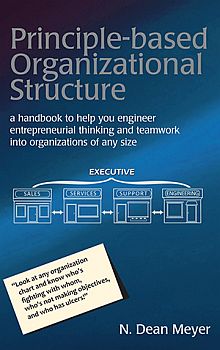Excerpt from www.NDMA.COM, © 2025 N. Dean Meyer and Associates Inc.

Executive Summary: The "Rainbow Analysis"
these four questions can diagnose the problems in an organization chart
by N. Dean Meyer
The "Rainbow Analysis" is a thorough, structured way to diagnose an organization chart and see where structure is getting in the way of people's performance -- who's set up to fight with whom, and who's set up to fail.

You can use this process to reveal the strengths and weaknesses of your current structure, or to examine a proposed organization chart before it's implemented.
You may do the Rainbow Analysis on your own. But it's most effective as a leadership-team workshop, to build a common understanding of the science of structure, and of the need for change.
One caveat: This process is not meant to make people defensive, or to accuse your organization of failing. Good people can overcome almost any structural dysfunction (if they work hard enough). The Rainbow Analysis highlights ways in which your structure makes it harder for people to succeed.
Data Collection: The process begins with an organization chart, such as your current structure or a proposed new structure. If you're doing the Rainbow Analysis in a workshop, print the organization chart in poster size, and put it up on the wall.
For one Building Block at a time, revisit the definition and interpret it in the context of the mission of your organization. Then, put a colored stripe under each box on the chart if it performs that function.
Definitions of the Building Blocks....
For example, put a red stripe under any box that's doing Sales work; a blue stripe under Applications Engineers; purple under Base Engineers; and so on. Your color coding indicates which Building Blocks are within each group.
| "Dean Meyer introduces you to a new organizational construct that makes sense and works." |
Carla Garnham
Special Assistant to the Provost
University of Wisconsin Milwaukee |
This data-collection step helps build a deeper understanding of the definitions of the Building Blocks, which is essential to learning and applying the science of structure.
It also provides the data for analysis.
Analysis: Four questions will reveal the obstacles to success built into your organization chart:
- Gaps: A full-service organization includes all of the Building Blocks. If any colors are missing (or are done part-time by many people but are nobody's primary focus), critical activities will not occur with reliability (it's "catch as catch can"). And quality will suffer since nobody has time to perfect the skills and methods.
- Rainbows: When a box is tagged with multiple colors, it's a "rainbow" group. This reduces specialization and performance, since staff can't be experts at all their different functions. It also risks conflicts of interests. For example, a group may be both a Service Provider (keep operations stable) and an Engineer (invent the next generation of technologies). It's rare that a group excels at such conflicting missions. And this conflict generates significant job-related stress.
- Scattered campuses: When a Building Block is scattered throughout the organization chart, professional exchange is diminished. Worse, no one short of the top executive is responsible for ensuring that the domain is covered completely and without overlaps. The result is often gaps (see above) and overlaps (redundant work, multiple parallel learning curves, dis-synergies from multiple disparate solutions to the same challenges, and internal competition).
- Inappropriate substructure: When a function is subdivided into groups based on anything other than its expertise, specialization (and hence performance) is reduced. This also induces inappropriate biases, since people naturally focus on the mission of their group instead of their professional specialty; for example, if an Engineering function is sub-divided by client, it will develop a deep knowledge of clients but less expertise in technology engineering (its real mission).
Once the weaknesses of an organization chart are revealed, a leadership team is in a position to make a fact-based decision about the need for structural change.
|


